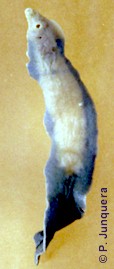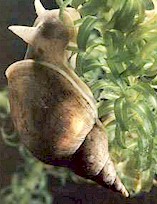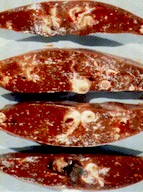Fasciola gigantica (= Distomum giganticum), the tropical liver fluke, is a parasitic flatworm belonging to the Trematodes. Final hosts are sheep, goats, cattle, buffaloes, horses, donkeys as well as other wild and domestic mammals, and also in humans.
The tropical liver fluke occurs in tropical and subtropical regions of Africa and Asia and has been reported also in Southern Europe and Hawaii.

It often appears together with Fasciola hepatica, the common liver fluke, and hybridization between both species is possible. Fasciola gigantica can be very focal, i.e. having a high prevalence (up to 100% of animals infected) in a particular region and being almost absent elsewhere.
Fasciola gigantica is one of the most abundant and damaging helminth parasites of grazing ruminants (sheep, goats, cattle) in endemic regions. Incidence in a particular region depends strongly on ecologic and climatic conditions (e.g. habitats for intermediate hosts and wild mammals, overwintering of the parasites in the environment, etc.) and on livestock management practices (stock density, grazing patterns, etc.).
Horses and pigs kept outdoors can also be affected, but liver flukes are usually not a problem in housed pigs.
The disease caused by liver flukes is called fasciolosis, fasciolasis, distomatosis or liver rot.
Are animals infected with Fasciola gigantica contagious for humans?
Usually NOT. If livestock is infected with liver flukes, they are not directly contagious for humans, neither through contact, nor when consuming meat, milk or blood of contaminated animals, nor through the feces. BUT experimental studies suggest that humans may be infected when consuming raw livers contaminated with juvenile liver flukes. The same applies to pets infected with liver flukes. Normally humans become infected through ingestion of water contaminated with infective cercariae (see below under life cycle), not by ingesting adult flukes or their eggs.
You can find additional information in this site on the general biology of parasitic worms and/or flukes.
Final location of Fasciola gigantica
Predilection sites of Fasciola gigantica are the biliary ducts in the liver and the gall bladder.
Anatomy of Fasciola gigantica
Adult liver flukes have a flat body and an oval shape, but are more elongated than Fasciola hepatica: they can reach up to 7.5 cm length. The have a pink-grayish to dark red color. Liver flukes have two suckers, both in the ventral side. The body surface is covered with numerous spines. Liver flukes have no external signs of segmentation.
The mouth ends in the pharynx, a muscular tube that allows sucking. The digestive system is blind (i.e. without exit: the only opening is the mouth) and not linear, as in most animals, but branched, ending in several blind ducts (called coeca). Liver flukes are simultaneous hermaphrodites, i.e. they have both male and female reproductive organs.
The eggs of Fasciola gigantica are slightly larger (100x180 micrometers) than those of Fasciola hepatica, but actually very difficult to distinguish. They have an oval shape, are operculated (i.e. with a cap-like cover), and of a yellowish to greenish color derived from the host's bile.
Life cycle and biology of Fasciola gigantica
Fasciola gigantica has an indirect life cycle with freshwater snails as the intermediate hosts, e.g. of the genus Lymnaea, Physopis, Radix, etc.

Adult flukes produce eggs in the biliary ducts of their hosts. These eggs reach the gall bladder and are passed to the host's gut when the gall bladder is emptied. They are passively transported downwards and are expelled with the feces. A single fluke can produce up to 25'000 eggs a day!
Once outside the host, the larvae called miracidia hatch out of the eggs in 7 to 15 days. These larvae can survive for weeks off a host provided there is enough humidity. They die quickly in a dry environment. Miracidia can swim and penetrate actively into the snails where they remain for 4 to 8 weeks and develop successively to sporocysts, rediae and cercariae, the usual larval stages of most fluke species. A single miracidium can asexually produce up to 600 cercariae.
Mature cercariae leave the snail, attach to the vegetation, lose their tail and produce cysts of about 0.2 mm, the so-called metacercariae, which are infective for the final host. Such cysts can survive for months in the vegetation, both under the water and under dry conditions, even in hay! Livestock becomes infected by grazing contaminated pastures or hay, i.e. animals kept indoors can also become infected if they are fed contaminated hay.
Inside the final host young immature flukes hatch out of the cysts and within a few hours they cross the intestinal wall and get into the abdominal cavity where they migrate towards the liver. To reach the biliary ducts they have to cross the hepatic tissue, a particularly harmful process for the host that lasts 6 to 8 weeks. Once in the biliary ducts they complete their development to adult flukes and start producing eggs.
The prepatent period of Fasciola gigantica is about 9 to 12 weeks, depending on the host and other factors.
Livestock grazing in swampy, marshy or flooded regions or close to water places are at high risk of becoming infected with the tropical liver fluke. Relatively small humid habitats (e.g. irrigation channels, ditches, ponds, watering holes, etc.) offer suitable conditions for the development of such snails and keep the surrounding pastures infected. Permanently stabled livestock can also become infected through contaminated hay.
Humans and carnivores such as dogs and cats are infected mainly ingesting aquatic plants or drinking water contaminated with cercariae. There is also evidence that consumption of raw liver contaminated with juvenile flukes can be contagious for humans.
Harm caused by Fasciola gigantica
 Tropical liver flukes are very harmful for their hosts, particularly for sheep and buffaloes, basically for the same reasons as Fasciola hepatica. Young immature flukes migrating through the liver tissues and crossing the wall of the bile ducts cause the major harm. This process destroys the tissues and causes bleeding. The spines in the surface of the flukes irritate the tissues that become inflamed. All this leads to cell death and fibrosis, i.e. the formation of excessive connective tissue that replaces the dead liver cells, which impairs the normal functioning of the liver.
Tropical liver flukes are very harmful for their hosts, particularly for sheep and buffaloes, basically for the same reasons as Fasciola hepatica. Young immature flukes migrating through the liver tissues and crossing the wall of the bile ducts cause the major harm. This process destroys the tissues and causes bleeding. The spines in the surface of the flukes irritate the tissues that become inflamed. All this leads to cell death and fibrosis, i.e. the formation of excessive connective tissue that replaces the dead liver cells, which impairs the normal functioning of the liver.
Affected livers increase in size and become fragile. Some flukes can become encapsulated in the liver tissues and build cysts as large as walnuts. The bile ducts are also damaged: they become thickened and can be calcified and even obstructed. Infections with secondary bacteria can also happen, mainly due to the general weakness of the host that debilitates its own immune system. In addition, flukes produce own toxins that impair the normal function of the liver.
The bottom line is that the numerous vital physiological processes that run in the liver are disturbed and the affected animals become sick in a degree that depends on the number of flukes that infect them. Infections with liver flukes are usually more harming for sheep (fatalities are not rare) than for cattle and other livestock. Besides fatalities the major economic damage is the consequence of reduced weight gains of young animals (up to 30% less, even after slight infections) and the condemnation of livers at slaughter. Light infection can already reduce milk production in dairy cattle.
Worlwide annual economic loss due to fasciolosis has been estimated to be over US$ 3 billion!
Symptoms and diagnosis of Fasciola gigantica infections
There are no really typical and easily recognizable symptoms of a liver fluke infection in livestock or other animals. The major symptoms are related with the inflammation of the liver (hepatitis) and of the bile ducts (cholangitis) that can be also due to other disorders. Other vital organs are usually not affected. Infections with a few dozen adult flukes may not cause clinical signs other than general weakness and reduced productivity.
Chronic fasciolosis is the more common form in sheep, goats and cattle. It develops along the gradual establishment of adult flukes in the bile ducts. It is characterized by the progressive development of such symptoms as anemia (reduced number of red blood cells), edema (local swellings due to excess fluid) often as "bottle jaw", digestive disturbances (diarrhea, constipation etc.), and cachexia (wasting, i.e. weight loss, fatigue, weakness, loss of appetite, etc.).
Acute fasciolosis is seldom in cattle but can occur in sheep. It is caused by the sudden migration of many immature flukes through the liver, which leads to complete organ failure. It can develop in healthy animals that may be killed in a few days.
Detection of eggs in the feces confirms the diagnosis. However, since the eggs are passed to the intestine only when the gall bladder is emptied, a negative fecal egg count is not conclusive, i.e. there can be false negatives. As already mentioned the eggs of Fasciola hepatica and Fasciola gigantica are very similar. It is also important to distinguish Fasciola eggs from Paramphistomum eggs that have a similar aspect.
Prevention and non-chemical control of Fasciola gigantica infections

Fasciola gigantica can infect virtually all mammal species, wild and domestic. Consequently it is almost impossible to eradicate it from a given property in endemic regions with favorable conditions. Therefore, where it is known to occur, preventive measures are a must to reduce the snail populations, the infection of pastures with infective stages, or the access to livestock to highly infested pastures.
Vector snails are aquatic and live in water (e.g. streams, lakes, pools, swamps, marshes, irrigation channels, ditches, ponds, watering holes, water logging, etc.). A typical habitat in many regions are rice fields. These snails are enormously prolific: a single snail can produce more than 100'000 snails within one year.
Whatever measures help keeping the pastures dry have to be encouraged, either to reduce the snail population, or to shorten the survival of encysted metacercariae, e.g.:
- Ensuring an adequate drainage
- Building watering points on solid ground, without puddles
- Make unavoidable ditches or channels less attractive to the snails: making the borders steeper and/or cover them with concrete, eliminate the surrounding vegetation, drying them completely out periodically, etc.
- Avoid water logging even very small water points that support the snails, e.g. hardened footprints (of shoes or car tires).
If permanent humid environments cannot be eliminated, they have to be fenced to prevent livestock from grazing there.
Rotational grazing is highly recommended to diminish fluke infestations. Simultaneous grazing of sheep and cattle is not advisable. Alternate grazing (e.g. sheep and cattle, sheep and horses, etc.) won't help, because liver flukes can infest all livestock.
Livestock infected with liver flukes can develop a certain level of natural immunity and become resistant, particularly cattle. Animals with chronic fasciolosis may recover spontaneously. However, such natural resistance is usually associated with hepatic fibrosis, i.e. a partial impairment of the liver function that will certainly result in a reduced productivity.
Some sheep breeds (e.g. Javanese thin-tailed sheep) seem to have a natural resistance to infections with Fasciola gigantica.
Keeping livestock healthy and well fed diminishes the harm caused by liver flukes and favors the development of the previously mentioned natural immunity.
There are so far no vaccines against liver flukes. To learn more about vaccines against parasites of livestock and pets click here.
Biological control of liver flukes (i.e. using their natural enemies) is so far not feasible.
You may be interested in an article in this site on medicinal plants against external and internal parasites.
Chemical control of Fasciola gigantica infections
Active ingredients with efficacy against flukes are usually called flukicides or fasciolicides. The following anthelmintics are used nowadays against liver flukes:
- Albendazole (benzimidazole), broad-spectrum anthelmintic. Effective also against most roundworms andtapeworms.
- Clorsulon (benzenesulphonamide), narrow-spectrum flukicide.
- Closantel (salicylanilide), medium-spectrum anthelmintic. Effective also against some gastrointestinal roundworms.
- Nitroxinil (halogenated phenol), medium-spectrum anthelmintic. Effective also against some gastrointestinal roundworms.
- Oxyclozanide salicylanilide), narrow-spectrum flukicide.
- Rafoxanide (salicylanilide), medium-spectrum anthelmintic. Effective also against some gastrointestinal roundworms.
- Triclabendazole benzimidazole), narrow-spectrum flukicide.
As previously mentioned migrating immature flukes are the most harmful stages, therefore efficacy against these stages is essential. Products without efficacy against immature flukes will not protect livestock from migrating flukes and need to be administered more frequently.
Neither macrocyclic lactones (e.g. ivermectin) nor levamisole are effective against liver flukes.
Several flukicides (e.g. bithionol, brotianide, diamfenetide, disophenol, hexachloroethane, carbon tetrachloride) used in the last century have been vastly abandoned and replaced by more effective and less toxic flukicides.
In many situations livestock needs to be protected not only against flukes but also against roundworms, less frequently against tapeworms as well. From all the flukicides previously mentioned only albendazole is a broad-spectrum wormer effective also against most roundworms and tapeworms, but its flukicidal efficacy is limited. For this reason mixtures are often used, typically ivermectin+ clorsulon, ivermectin + nitroxinil, triclabendazole+ levamisole, etc.
For use on livestock these active ingredients, alone or mixtures, are mostly available as drenches for oral delivery, as injectables or as slow-release boluses. Solid formulations (e.g. tablets, pills, etc, feed additives, etc.) are rather seldom for livestock.
There are very few commercial flukicides approved for use on pig, poultry, and horses simply because flukes are seldom a problem for them.
In endemic regions strategic use (i.e. preventative or prophylactic use) of flukicides combined with the previously mentioned preventive measures is highly recommended. Delaying the treatments until the first symptoms become evident (i.e. therapeutic or curative use) is often too late: most harm has been already done and probably the pastures have been already contaminated with fluke eggs. Best timing for such preventative treatments depend strongly on local climatic and ecologic conditions that drive the snail population.
Chemical control of the snails with molluscicides (i.e. snail killers) such as copper sulphate, sodium pentachlorophenate, niclosamide, etc. can make sense for very specific purposes, e.g. for treating places where livestock congregates (water holes, feeding areas, salt licks, shade trees, etc) to keep them free of snails. However, trying to eradicate snails from a property is hopeless and useless. It is virtually impossible to treat every place where they can survive and they reproduce extremely quickly. Cleaned pastures would become re-infested very fast. In addition, it would be too expensive and very harmful for the environment. In fact, such molluscicides are not approved in most countries.
|
Ask your veterinary doctor! If available, follow more specific national or regional recommendations or regulations for liver fluke control. |
Resistance of Fasciola gigantica to flukicides
So far there are no reports on resistance of Fasciola gigantica to flukicides.
If a flukicide fails to achieve the expected efficacy, chance is very high that either the product was unsuited for the control of Fasciola gigantica, or it was used incorrectly. However, it is often difficult to distinguish between Fasciola gigantica and Fasciola hepatica infections, and Fasciola hepatica is known to have developed resistance to several flukicides in various regions.
To prevent or at least delay the development of resistance it is highly recommended to periodically change the chemical class of the product used, before resistance is suspected, e.g. every one or two years. This is usually called rotation.